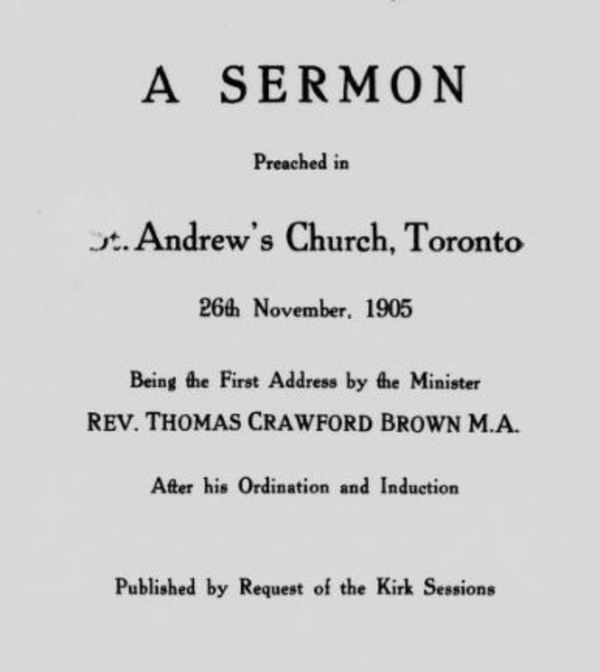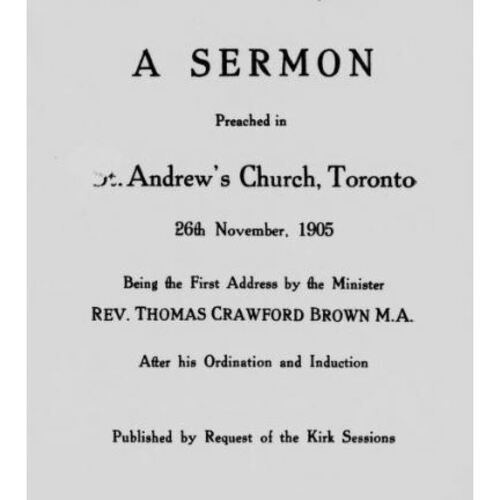
Source: Link
CRAWFORD BROWN, THOMAS, Presbyterian minister and military chaplain; b. 18 Jan. 1874 in Richmond, Carleton County, Ont., son of Thomas Brown, a Scots pioneer farmer, and Sarah Crawford; m. 16 June 1909, in Toronto, Eallien Necora Melvin-Jones (d. 1933), only daughter of Lyman Melvin Jones*, and they had a son and a daughter; d. there 9 July 1929.
Thomas Crawford Brown was one of the most renowned churchmen of his day in Toronto. From a humble birth he achieved an education which exceeded that of most of his peers. After attending the public school in Richmond and the collegiate school in Almonte, he enrolled in arts at Queen’s College in Kingston, where he also completed the course in theology; he obtained a ba in 1903 and an ma in 1904. An outstanding scholastic record at Queen’s was highlighted by his winning the double gold medal in philosophy, the gold medal in political science, and the Sir John A. Macdonald prize. These awards, and the recommendation of Principal Daniel Miner Gordon, led to postgraduate work in arts and theology at the University of Edinburgh (1904–5). In Edinburgh, Crawford Brown was ordained a deacon and served as first assistant minister at St Giles’ Cathedral.
Crawford Brown’s desire for the ministry drew him back to Canada, where he received a call to St Andrew’s Presbyterian Church, Toronto. He was ordained and inducted as minister on 16 Nov. 1905. It was virtually unprecedented for a new graduate to be called to a large metropolitan congregation, but at first glance there was much to commend him as a clergyman. With strong features, exceptional good looks, and a frame over six feet in height, he brought a commanding presence to the pulpit. Initially, however, the position at St Andrew’s seemed more than he could handle. Lacking self-confidence, he failed to provide leadership and dreaded the pressures of weekly preaching. Dr Thomas Eakin came to his rescue and acted as his mentor and pulpit assistant. Crawford Brown also rallied within himself, drawing upon his education and experiences at St Giles’, to confront the personal and ministerial battles that awaited him.
Believing that worship at St Andrew’s lacked proper decorum and reverence, Crawford Brown changed the order of service to reflect the liturgy of St Giles’; he also had the interior remodelled to provide for a chancel and a central aisle. He championed the drive for a new organ at St Andrew’s, and by 1908 the church had a second instrument, completely constructed by Casavant Frères within its confines. Crawford Brown fought tirelessly against church union, and his efforts were not in vain. In 1912 the first congregational vote on the matter showed 47 members for union and 182 against. A similar poll on 22 Dec. 1924 recorded 19 votes in favour and 733 opposed. St Andrew’s stayed out of the United Church of Canada and continued with the ongoing Presbyterian Church in Canada.
In August 1908, at age 34, Crawford Brown had become sick with an unknown illness that required a seven-month leave of absence. Poor health would continue to plague his ministry and force him to resign from St Andrew’s in May 1915. The minutes of the kirk session record the elders’ dismay at losing him and their appreciation for “his high standard of personal character, his loyalty to the forms and service of the Church, his declaration of a free Gospel, and the consoling power of his ministrations in the house of mourning.” Crawford Brown had been determined that illness would not deprive him of personal happiness and charitable endeavour. On 16 June 1909, at St Andrew’s, he had married Eallien Necora Melvin-Jones, a union that produced two children. Despite a young family and an active ministry he found time to participate in many organizations: the House of Industry, the provincial council of the Victorian Order of Nurses, the dominion council of the British and Foreign Sailors’ Society, the Navy League of Canada, the masonic order, the St Andrew’s Society, the Canadian Club, the Empire Club of Canada, the Victoria Club, the Toronto Skating Club, the Canadian Military Institute, and the Canadian Institute.
When World War I broke out Crawford Brown fully expected to proceed overseas with the 48th Highlanders, the regiment which had appointed him chaplain in 1907, but on 23 Aug. 1914 he was informed that because of continuing bad health he would not accompany his unit to England. His chaplaincy work continued at the military barracks in Exhibition Park, Toronto. In 1917 he became, in addition, a chaplain at the Royal Flying Corps’ No.4 School of Military Aeronautics, University of Toronto, and at other RFC stations in the Toronto area. The following year, his health evidently improved, he would be seconded to the chaplain service of the Canadian Expeditionary Force, but he did not go overseas. An honorary major, he was demobilized in 1919. Crawford Brown had been an ardent supporter of voluntary enlistment and later conscription; he served as the president and chairman of the Ministerial Patriotic League of Canada and honorary secretary of the Speakers’ Patriotic League.
In November 1918 Crawford Brown’s health was again compromised by a severe attack of influenza leading to broncopneumonia. Unable to resume full-time ministry, he became a popular supply minister, preaching in hundreds of churches over the next 11 years. He also continued his duties as padre to the 48th Highlanders, officiating at the presentation of the regiment’s second stand of colours on 24 May 1925 and participating in its celebration of the tenth anniversary of peace on 11 Nov. 1928. He worked tirelessly in favour of his most cherished causes, especially as Canadian representative of the British Settlement Society. Returning in 1929 from a voyage to England in connection with this organization he became seriously ill with an embolism on board ship. After his arrival home the family believed that his recovery was certain; however, the blood clot intensified and he died on 9 July. Even though his ministry at St Andrew’s had ended 14 years before, he was deeply mourned by the people there. “St. Andrew’s felt,” the congregation’s historian remarked, “that it had suffered infinite loss. . . . rich and poor, gathering about his grave, felt that a gracious personality had passed out of their lives, leaving only a memory behind, but an inspiring memory.”
AO, RG 22-305, no.63082; RG 80-5-0-388, no.2932. 48th Highlanders Museum (Toronto), Regimental records, 1907, 1914, 1925, 1928. LAC, RG 150, Acc. 1992-93/166, box 1180-16. QUA, Queen’s Hist. coll., Deceased alumni ser., locator no.3599. St Andrew’s Presbyterian Church (Toronto), Minutes of the kirk session, 1905-29. Globe, 3 March 1915: 11; 10 July 1929: 13. Mail and Empire (Toronto), 3 March 1915, 10 July 1929. Kim Beattie, Dileas: history of the 48th Highlanders of Canada, 1929-1956 ([Toronto, 1957]). Can., Dept. of Militia and Defence, Militia list (Ottawa), 1907-22. Duff Crerar, Padres in no man’s land: Canadian chaplains and the Great War (Montreal and Kingston, 1995). Middleton, Municipality of Toronto. National encyclopedia of Canadian biography, ed. J. E. Middleton and W. S. Downs (2v., Toronto, 1935-37), 1: 24-25. S. C. Parker, The book of St. Andrew’s: a short history of St. Andrew’s Presbyterian Church, Toronto (Toronto, 1930). Presbyterian Record (Toronto), 54 (1929). Queen’s College and Univ., Calendar (Kingston), 1897/98-1905/6. “Rev. T. Crawford Brown, ma,” Presbyterian Church in Canada, General Assembly, Acts and proc. (Toronto), 1930, app.: 303. Standard dict. of Canadian biog. (Roberts and Tunnell), vol.1: 128-29.
Cite This Article
Thomas Hamilton, “CRAWFORD BROWN, THOMAS,” in Dictionary of Canadian Biography, vol. 15, University of Toronto/Université Laval, 2003–, accessed January 19, 2026, https://www.biographi.ca/en/bio/crawford_brown_thomas_15E.html.
The citation above shows the format for footnotes and endnotes according to the Chicago manual of style (16th edition). Information to be used in other citation formats:
| Permalink: | https://www.biographi.ca/en/bio/crawford_brown_thomas_15E.html |
| Author of Article: | Thomas Hamilton |
| Title of Article: | CRAWFORD BROWN, THOMAS |
| Publication Name: | Dictionary of Canadian Biography, vol. 15 |
| Publisher: | University of Toronto/Université Laval |
| Year of publication: | 2005 |
| Year of revision: | 2005 |
| Access Date: | January 19, 2026 |



